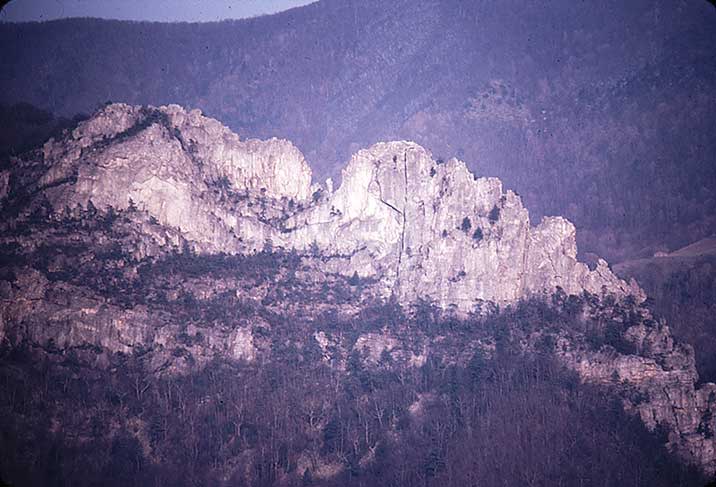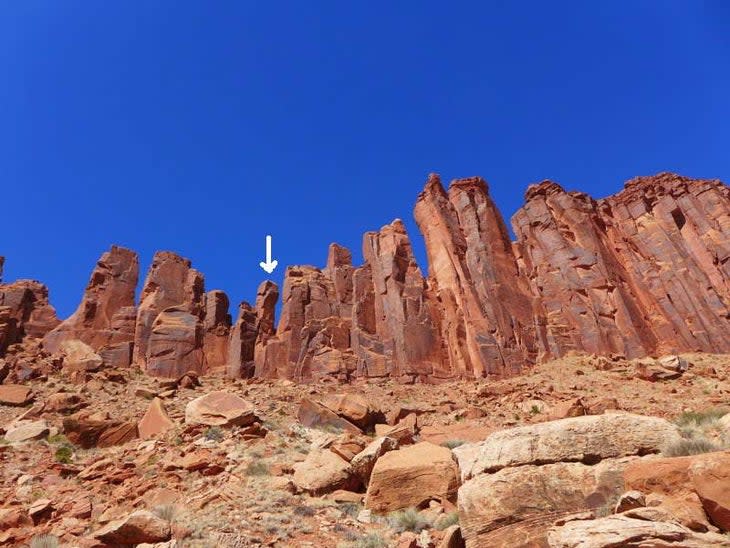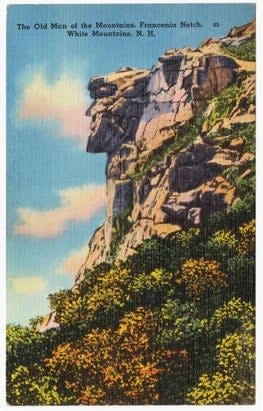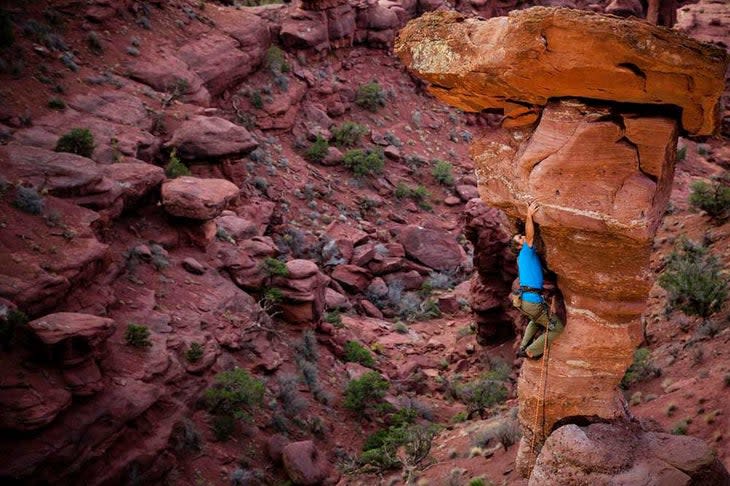5 Famous Climbing Features that Fell Off—or Over
This article originally appeared on Climbing
Standing at the base of the Gendarme, Elizabeth Doyle almost felt she could wrap her arms around the pedestal.
What is holding this thing on here? she thought. It's obviously cracking--that's how you climb it!
The Gendarme was a slender 40-foot pinnacle in the center notch of the beautiful 300-foot quartzite fin of Seneca Rocks, West Virginia.
She recalls, "I could see myself standing on top as the whole pillar fell silently and majestically, like a swan dive, until it and I exploded on the scree far below."
She wanted to stay put. But her friends jeered, so she climbed the Gendarme.
"I have never," she says, "stayed for such a short period on a 'summit.'"
She was a pretty good judge. In fact, she is now a judge, in county court in Pennsylvania. A few short years later, the Gendarme, once worshipped by the Seneca tribe and later climbed by many--an ascent was a high point of local climbing courses--crashed to the ground at 3:27 p.m. on October 22, 1987. Only one person saw it go, an 11-year-old named Brock Markwell, who was outside at the local elementary school.
***
Things fall apart. In climbing, that can mean whole walls in far mountains, sections of cliffs from the San Jacintos to the Adirondacks and White Mountains, and iconic forms or features on area crags. Early August 2014 brought news that the 40-foot Cobra Tower, in the Fisher Towers near Moab, Utah, had collapsed, news that made some sad, many reflect on impermanence, and ascentionists feel plenty lucky.
We climbers go up, but these things can come down.
Herewith, in chronological order, a gallery of climbing features that have cratered. And a few ideas for what's next.

The Gendarme may have been undone by freeze-thaw cycles: in the night, temps had dropped to 20 degrees F., but they rose to 80 F. on that warm autumn day. Another theory is that the Air Force jets that often flew above the valley, purportedly above the sound barrier, may have jarred the tower.
People knew the tower would go sometime, though. I saw it there my first visit, and it was gone the next.
Beach Crack, Mickey's Beach, San Francisco Bay Area, 1994. Beach Crack was a famous 5.12b in one of the Bay Area's most beautiful regions, and some climbers were working the line, perhaps as a first 5.12, up until the day it went. The route--or rather, half of it--fell, along with Scott Frye's famous 5.13b/c Plate-o-Shrimp and two others, during a huge storm. On the plus side, when the right half of the crack climb fell, it bared Mickey's Beach Arete (5.13c).
The colorful seaside atmosphere here includes crashing waves, the smell of the brine, tide pools, starfish, sea otters, shore birds ... nudists ... and, at one time, a character in costume.
On May 25, Memorial Day, 1981, "Spider Dan" Goodwin soloed the Sears Tower, then the tallest building in the world, using suction cups and camming devices and wearing a Spiderman suit. Soon after, he was seen toproping the Beach Crack, in a blue Lycra suit with a red cape, though at that point he'd been warned off the Spiderman logo. The rock at Mickey's Beach is slick even on a dry day. Credit Goodwin for boldness when he soloed the route.
You can watch this old video of his solo, complete with extra moves, a bit of choreography that never (thank god, since it looks really dangerous), caught on.

The Chockstone on Easter Island, Bridger Jack Towers, Canyonlands, Utah, March 31, 2002. This feature was, as Mountain Project described it, "the unique chockstone bridging the gap" between the first and second pitches of the three-star Thunderbolts (5.10), put up by Jeff Achey. People belayed beside the piano-sized rock, and then stepped upon it to gain
the face of the crux second pitch.
Parties had climbed the route the day before, and more were heading up toward the tower and route the morning it fell: on Easter Sunday. Really.
Wrote a poster on Mountain Project: "I was camped underneath the Bridgers and watched the piano block fall out. Had climbed the route the evening previous, super fun."
The Old Man of the Mountain, May 3, 2003. When you rounded a bend and saw the Old Man, the glacier-carved craggy profile high on Cannon Cliff, Franconia Notch, in the White Mountains of New Hampshire, you felt a thrill. The sight signaled arrival at the vast granite face, 1,000 feet at its highest, with all the adventure of its routes and unpredictable weather. If you climbed to the top and walked down rather than rappelling, you stepped around the big concrete blocks, steel cables and turnbuckles that were part of a hundred-year effort to stave off the predations of freeze-thaw cycles on this state symbol.

The famous eight-pitch Lakeview (5.6) finished up a corner (climbed in 1933 by Fritz Wiessner and Robert Underhill) to the top of the Old Man's head, and two routes tackled his overhanging front face. One line was what the guidebook called the "spectacular free climb" of Bubba Marty (5.11), done in 1982 by Dave Anderson and Mike Kenney. The other was Cheek to Cheek, also 1982, a 5.10 by Steve Larson and Andy Tuthill on corners and overhangs up the Old Man's throat and face.
Larson, then 26, remembers asking Tuthill that day, "Whattaya think's out there?"
"Why don't I try to traverse out and have a look?"
Tuthill cast off and set up a hanging belay right below the Old Man's chin.
Recalls Larson, "Tourists for years had admired that square jaw, and I was delighted to see the finger crack in the corner."
Some 20 years later, the Old Man of the Mountain fell, sometime between midnight and 2:00 a.m., after a spring rainstorm. "Apparently the Adam's apple gave way first," says Larson, "and the Old Man just slid down the slabs."
The Cobra, Fisher Towers, Utah, sometime between July 31 and the first week of August, 2014. Rumors of the fall of the tower, shaped like a rising cobra, were long an April Fools' staple. But this time the news was for real. The collapse was of not just the top block of the formation, as would be expected, but the whole hood outline that gave the cobra its shape. The extent may have indicated a lightning strike.
Many had climbed the 40-foot hoodoo, via a 5.11 first done in 1995 by Jimmie Dunn, who wrapped his dog's leash around the column as pro.

Steve "Crusher" Bartlett, climber and author, has written on Mountain Project of the experience: "So unlikely, yet so much fun, and semi-terrifying too. Once I was on top, the wind almost blew me right back off, and, acutely aware that a windy day is just the kind of day which will see this thing fall over, I stayed perhaps a second, before lowering, mildly gibbering, to the ground."
No one witnessed the destruction when a violent storm, with rain and high winds, swept through.
***
What's next?
Well, high on the list of candidates should be three items that have starred in hoaxes. Variously said to have fallen off are the Split Pillar, whose inside
edge creates a laser-cut pumpy layback on the Grand Wall, the Chief, Squamish; the pasted-on Boot Flake, also providing a steep layback, on the Nose, El Capitan; and the Totem Pole, Tasman Peninsula, Australia. See video of Mayan Smith-Gobat and Ben Rueck climbing it.
Of course, there's also a Totem Pole in Queen Creek Canyon, Arizona. And Totem Pole in Monument Valley...
To me the top pick, come earthquake or high water, would be the popular fluted spire that is the most popular finish for a route (usually Stolen Chimney, 5.10) on the 300-foot Ancient Art formation, the Fisher Towers. In 2011 Katie Brown and Alex Honnold spent two days there filming a Citibank commercial. The viewing public went nuts: people thought the ad was faked; got vertigo looking at the shots taken from Brown's helmet cam; wondered who that "cute" and awesome girl was. Jeanne Moos of CNN did a funny little segment on the furor.
This article was originally published in Rock and Ice in 2014.
Also Read
Katie Brown's Book 'Unraveled' Broke My Heart. I'm Glad I Read It
Are you a Gumby, a Regular Joe/Jane, or an Elite Climber? Take Our Quiz and Find Out
For exclusive access to all of our fitness, gear, adventure, and travel stories, plus discounts on trips, events, and gear, sign up for Outside+ today.


